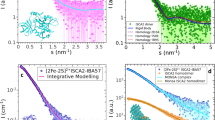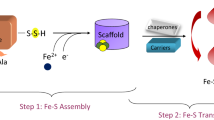Abstract
The CIAO3 protein operates at a crossroad of the cytosolic iron–sulfur protein assembly (CIA) machinery. Although the functional role of CIAO3 has been recently characterized, a description of its interaction network is still not complete. Literature data suggested that CIAO3 interacts individually with CIA2A and CIAO1 protein, with the latter two interacting each other. However, no experimental data are available yet showing the formation of a possible ternary complex composed by CIAO3, CIAO1, and CIA2A. This work shows, for the first time, via size exclusion chromatography coupled with multiangle light scattering, UV–vis absorption and electron paramagnetic resonance (EPR) spectroscopies, the formation of a stable, [4Fe-4S]-bound, complex, composed by CIAO3 and the hetero-CIA2A–CIAO1 complex. Moreover, site-directed mutagenesis data suggested a structural role for the C-terminal [4Fe-4S] cluster of the CIAO3 protein. These findings can provide solid bases for further investigation of the molecular mechanisms involving these CIA machinery proteins.






Similar content being viewed by others
Abbreviations
- IRP1:
-
Iron regulatory protein 1
- CIA:
-
Cytosolic iron–sulfur protein assembly
- EPR:
-
Electron paramagnetic resonance
References
Andreini C, Putignano V, Rosato A, Banci L (2018) The human iron-proteome. Metallomics 10:1223–1231.
Bertini I, Sigel A (2001) Handbook on metalloproteins, 1 edizione. CRC Press, New York
Lill R (2009) Function and biogenesis of iron-sulphur proteins. Nature 460:831–838
Johnson DC, Dean DR, Smith AD, Johnson MK (2005) Structure, function, and formation of biological iron–sulfur clusters. Annu Rev Biochem 74:247–281
Maio N, Rouault TA (2015) Iron–sulfur cluster biogenesis in mammalian cells: New insights into the molecular mechanisms of cluster delivery. Biochim Biophys Acta 1853:1493–1512
Ciofi-Baffoni S, Nasta V, Banci L (2018) Protein networks in the maturation of human iron–sulfur proteins. Metallomics 10:49–72.
Netz DJ, Mascarenhas J, Stehling O et al (2014) Maturation of cytosolic and nuclear iron–sulfur proteins. Trends Cell Biol 24:303–312
Sharma AK, Pallesen LJ, Spang RJ, Walden WE (2010) cytosolic iron–sulfur cluster assembly (CIA) system: factors, mechanism, and relevance to cellular iron regulation. J Biol Chem 285:26745–26751
Lill R, Dutkiewicz R, Freibert SA et al (2015) The role of mitochondria and the CIA machinery in the maturation of cytosolic and nuclear iron–sulfur proteins. Eur J Cell Biol 94:280–291
Stehling O, Netz DJA, Niggemeyer B et al (2008) Human Nbp35 is essential for both cytosolic iron–sulfur protein assembly and iron homeostasis. Mol Cell Biol 28:5517–5528
Netz DJA, Pierik AJ, Stümpfig M et al (2007) The Cfd1–Nbp35 complex acts as a scaffold for iron–sulfur protein assembly in the yeast cytosol. Nat Chem Biol 3:278–286
Banci L, Bertini I, Calderone V et al (2013) Molecular view of an electron transfer process essential for iron–sulfur protein biogenesis. Proc Natl Acad Sci USA 110:7136–7141
Banci L, Ciofi-Baffoni S, Mikolajczyk M et al (2013) Human anamorsin binds [2Fe–2S] clusters with unique electronic properties. J Biol Inorg Chem 18:883–893
Netz DJA, Stümpfig M, Doré C et al (2010) Tah18 transfers electrons to Dre2 in cytosolic iron–sulfur protein biogenesis. Nat Chem Biol 6:758–765
Banci L, Ciofi-Baffoni S, Gajda K et al (2015) N-terminal domains mediate [2Fe-2S] cluster transfer from glutaredoxin-3 to anamorsin. Nat Chem Biol 11:772–778
Banci L, Camponeschi F, Ciofi-Baffoni S, Muzzioli R (2015) Elucidating the molecular function of human BOLA2 in GRX3-dependent anamorsin maturation pathway. J Am Chem Soc 137:16133–16143
Mühlenhoff U, Molik S, Godoy JR et al (2010) Cytosolic monothiol glutaredoxins function in intracellular iron sensing and trafficking via their bound iron–sulfur cluster. Cell Metab 12:373-385
Li H, Mapolelo DT, Randeniya S et al (2012) Human glutaredoxin 3 forms [2Fe-2S]-bridged complexes with human BolA2. Biochemistry 51:1687–1696
Frey AG, Palenchar DJ, Wildemann JD, Philpott CC (2016) A Glutaredoxin·BolA complex serves as an iron–sulfur cluster chaperone for the cytosolic cluster assembly machinery. J Biol Chem 291:22344–22356
Paul VD, Lill R (2015) Biogenesis of cytosolic and nuclear iron–sulfur proteins and their role in genome stability. Biochim Biophys Acta 1853:1528–1539
Seki M, Takeda Y, Iwai K, Tanaka K (2013) IOP1 protein is an external component of the human cytosolic iron–sulfur cluster assembly (CIA) machinery and functions in the MMS19 protein-dependent CIA pathway. J Biol Chem 288:16680–16689
Balk J, Pierik AJ, Netz DJA et al (2004) The hydrogenase-like Nar1p is essential for maturation of cytosolic and nuclear iron–sulphur proteins. EMBO J 23:2105–2115
Hausmann A, Aguilar Netz DJ, Balk J et al (2005) The eukaryotic P loop NTPase Nbp35: an essential component of the cytosolic and nuclear iron–sulfur protein assembly machinery. Proc Natl Acad Sci USA 102:3266–3271
Yarunin A, Panse VG, Petfalski E et al (2005) Functional link between ribosome formation and biogenesis of iron–sulfur proteins. EMBO J 24:580
Song D, Lee FS (2011) Mouse knock-out of IOP1 protein reveals its essential role in mammalian cytosolic iron–sulfur protein biogenesis. J Biol Chem 286:15797–15805
Huang J, Song D, Flores A et al (2007) IOP1, a novel hydrogenase-like protein that modulates hypoxia-inducible factor-1α activity. Biochem J 401:341–352
Urzica E, Pierik AJ, Mühlenhoff U, Lill R (2009) Crucial role of conserved cysteine residues in the assembly of two iron−sulfur clusters on the CIA protein Nar1. Biochemistry (Mosc) 48:4946–4958
Stehling O, Mascarenhas J, Vashisht AA et al (2013) Human CIA2A-FAM96A and CIA2B-FAM96B integrate iron homeostasis and maturation of different subsets of cytosolic-nuclear iron-sulfur proteins. Cell Metab 18:187–198
Rual J-F, Venkatesan K, Hao T et al (2005) Towards a proteome-scale map of the human protein-protein interaction network. Nature 437:1173–1178
Maione V, Cantini F, Severi M, Banci L (2018) Investigating the role of the human CIA2A–CIAO1 complex in the maturation of aconitase. Biochim Biophys Acta BBA Gen Subj 1862:1980–1987
Banci L, Bertini I, Ciofi-Baffoni S et al (2011) Anamorsin is a [2Fe-2S] cluster-containing substrate of the Mia40-dependent mitochondrial protein trapping machinery. Chem Biol 18:794–804
Guerrini O, Burlat B, Léger C et al (2008) Characterization of two 2[4Fe4S] ferredoxins from Clostridium acetobutylicum. Curr Microbiol 56:261–267
Webb B, Sali A (2016) Comparative protein structure modeling using MODELLER. Curr Protoc Bioinform 54:5–60
Pandey AS, Harris TV, Giles LJ et al (2008) Dithiomethylether as a ligand in the hydrogenase H-cluster. J Am Chem Soc 130:4533–4540
Chawla M, Parikh P, Saxena A et al (2012) Mycobacterium tuberculosis WhiB4 regulates oxidative stress response to modulate survival and dissemination in vivo. Mol Microbiol 85:1148–1165
Kennedy MC, Antholine WE, Beinert H (1997) An EPR investigation of the products of the reaction of cytosolic and mitochondrial aconitases with nitric oxide. J Biol Chem 272:20340–20347
Flint DH, Emptage MH, Finnegan MG et al (1993) The role and properties of the iron-sulfur cluster in Escherichia coli dihydroxy-acid dehydratase. J Biol Chem 268:14732–147424
Peters JW (1999) Structure and mechanism of iron-only hydrogenases. Curr Opin Struct Biol 9:670–676. https://doi.org/10.1016/S0959-440X(99)00028-7
Acknowledgements
We thank Dr. A. Bonucci (CERM) for assistance in recording the EPR spectra. This work was supported by Fondazione Cassa di Risparmio di Firenze project title “Dalla Struttura tridimensionale di antigeni proteici all’ottimizzazione di potenziali candidati vaccini” and by Instruct-ERIC, a Landmark ESFRI project, and specifically, we thank the CERM/CIRMMP Italy Centre. Financial support was also provided by European EC Horizon2020 TIMB3 (Project 810856).
Author information
Authors and Affiliations
Corresponding authors
Ethics declarations
Conflict of interest
The authors declare that they have no conflicts of interest with the contents of this article.
Additional information
Publisher's Note
Springer Nature remains neutral with regard to jurisdictional claims in published maps and institutional affiliations.
Electronic supplementary material
Below is the link to the electronic supplementary material.
Rights and permissions
About this article
Cite this article
Maione, V., Grifagni, D., Torricella, F. et al. CIAO3 protein forms a stable ternary complex with two key players of the human cytosolic iron–sulfur cluster assembly machinery. J Biol Inorg Chem 25, 501–508 (2020). https://doi.org/10.1007/s00775-020-01778-z
Received:
Accepted:
Published:
Issue Date:
DOI: https://doi.org/10.1007/s00775-020-01778-z




